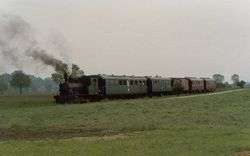Sursee–Triengen railway
| Sursee-Triengen-Bahn | |
|---|---|
 | |
|
Steam train between Sursee and Triengen, 7 May 1988 | |
| Operation | |
| Opened | 23 November 1912 |
| Technical | |
| Line length | 8.9 km (5.53 mi) |
| Number of tracks |
Single track with passing loops |
| Track gauge | 1,435 mm (4 ft 8 1⁄2 in) |
| Minimum radius | 250 m (820 ft) |
| Maximum incline | 15 ‰ or 1.5 % |
| Sursee-Triengen-Bahn | ||||||||||||||||||||||||||||||||||||
|---|---|---|---|---|---|---|---|---|---|---|---|---|---|---|---|---|---|---|---|---|---|---|---|---|---|---|---|---|---|---|---|---|---|---|---|---|
| Infrastructure | ||||||||||||||||||||||||||||||||||||
Legend
| ||||||||||||||||||||||||||||||||||||
The Sursee–Triengen-Bahn (ST) is a small railway company in Switzerland. It owns a railway line of only 8.9 km between Sursee, where it connects to the SBB-CFF-FFS network, and Triengen. The line was opened on 23 November 1912 with steam traction. Unlike most other railways in Switzerland, it was never electrified but a small diesel locomotive was purchased in 1965.
Steam locomotives
Traffic had started with two small steam locomotives E 2/2 1 and 2 and in 1917 a steam motor coach joined them. This unique FZm 1/2 11 had mail and baggage compartments. 1961-1963 these three vehicles reached the end of their lives and were replaced by used SBB E 3/3 "Tigerli". The first two of them (3 ex 8477 and 4 ex 8488) had soon to be replaced by two others (5 ex 8479 and 8522). 1960-64 a leased tramway-type ("Glaskasten") Ed 2/2 from VHB was in use. E 3/3 5 and 8522 were kept as replacements for the new diesel.
Planned extension
There had been many plans and long discussions about a through going Suhre valley railway. This would have been the existing, 10.18 kilometres (6.33 mi) long 1,000 mm (3 ft 3 3⁄8 in) metre gauge Aarau–Schöftland line of the Wynental and Suhrental railway (WSB), a new meter gauge line Schöftland–Triengen and a third rail in the track of the Sursee–Triengen railway, including electrification. Electric meter gauge trains would have made the journey from Aarau to Sursee. Freight traffic could have continued on standard gauge to Triengen, similar to Wohlen–Bremgarten of the BDWM. But it wasn't the time to build new secondary railways then and furthermore Triengen and Schöftland are situated in different cantons. On 25 September 1971 regular passenger traffic of the ST ended and a new bus service Sursee–Triengen–Schöftland connected with the modernized WSB line.
Current operation
Freight traffic continued and in 1976 a second diesel of SBB Tm IV type arrived. When the nostalgia-boom reached Switzerland, ST gave its steam 8522 engine to the Dampfbahn Bern which gave it an overhaul and used it for some time. Having kept the old passenger coaches, ST began to offer steam train runs. Remarkable thing is that 8522 is one of the two locomotives that were "partly electrified" during World War 2. An electric boiler heating should replace rare coal. But when the war was over and supply restarted, pantograph and electric heater were removed .[1]
After the 1999 reform of railway law, SBB Cargo decided to bring freight cars to their destinations in open access. It took over Tm IV 2 from ST. So, the ST of today is an infrastructure and steam train company.
Future
A study about the feasibility of reinstating passenger traffic and a possible extension to Schöftland commissioned by the Sursee-Triengen company with ETH Zurich [2] was published in May 2009. The municipality Triengen opposes passenger rail traffic, as access to settlements seems to be better by road transport. Furthermore, the municipality would have to cover part of the potential higher deficit.[3]
Sources and links
| Wikimedia Commons has media related to Sursee-Triengen-Bahn. |
- Daniel Zumbühl, 75 Jahre Sursee–Triengen-Bahn, (offizielle Festschrift). E.B.Leutwiler Verlag, Zürich, 1987, ISBN 3-906681-05-X
- official homepage of the company
- References:
- ↑ The Railway Magazine, August 2009, page 38: Kettles on wheels!
- ↑ Weidmann Ulrich, Rieder Markus, Patrick Frank, Silko Höppner (2009):Wiedereinführung des Personenverkehr auf der Sursee-Triengen-Bahn und einer allfälligen Verlängerung Vorstudie, Institut für Verkehrsplanung und Transportsysteme (IVT), ETH Zurich, Zürich (German, pdf, 3.87 MB)
- ↑ Gemeinde Triengen, 27. April 09 : Aus dem Gemeinderat found on Triengen Online under the heading Neuigkeiten on 12 July 2009 (German).
